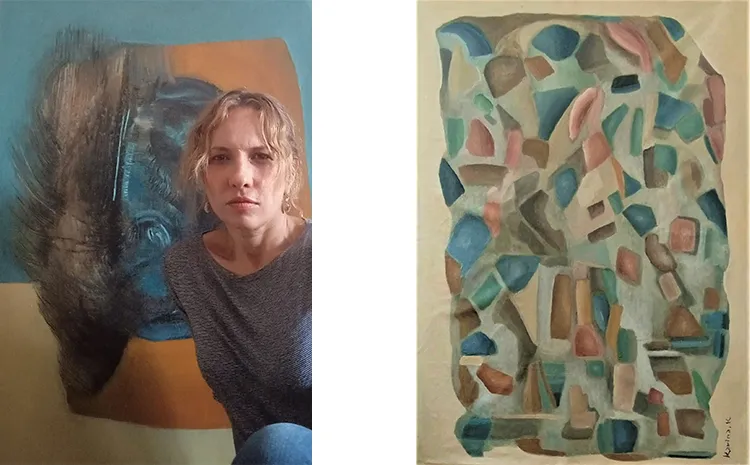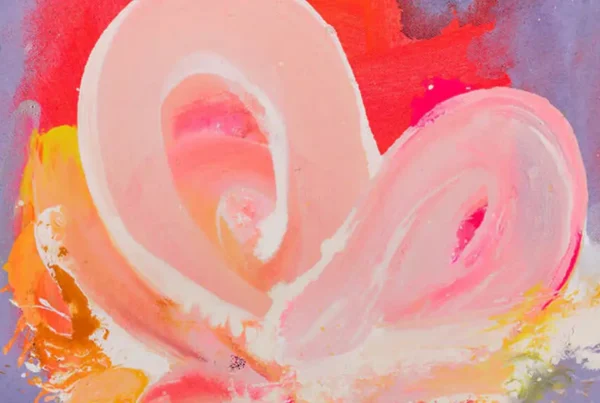“I discovered the ability to sense the essence of a painting before admiring its technique.”
Karina Khider: A Journey from Corporate Life to Creative Liberation
Born and raised in Algeria, Karina Khider spent the first 22 years of her life immersed in the vibrant culture of her homeland before moving to Tunisia in 1996, where she has since resided. Despite her early years spent in the business world as a sales manager, Khider eventually discovered a profound sense of unfulfillment. It wasn’t until she picked up a paintbrush that she realized how much she craved a deeper form of expression. Painting quickly became her sanctuary, allowing her to navigate the complexities of her emotions and experiences. Through her art, music, philosophy, and travel, Khider found a way to build a private universe where creativity could thrive without the constraints of her former corporate life.
Khider’s extensive travels have also deeply influenced her artistic journey. Exposure to diverse cultures and the opportunity to visit some of the world’s most iconic museums provided her with a global perspective on art. These experiences opened her eyes not only to the technical prowess of various artists but also to the emotional power that artworks can evoke. She learned to appreciate paintings not only for their aesthetics but for their ability to stir something deeper within the viewer. This emotional connection would become a cornerstone of her own creative practice, leading her to pursue art as a full-time endeavor later in life.
In 2016, Khider began painting, initially keeping her work private. It wasn’t until the pandemic in 2020 that she began to share her art with the world. As she channeled her emotions into her work during this time of global uncertainty, her creations resonated with a larger audience, marking a pivotal turning point in her life and career. Painting was no longer just a personal escape; it had become her purpose.

Karina Khider: A Style Rooted in Emotion and Intuition
Khider’s contemporary art style blends a variety of influences, from surrealism to the interplay of light and shadow, though she doesn’t consciously choose specific themes when she begins a new piece. Her approach to art is highly intuitive, allowing her to explore contrasts and depth organically. Recurring motifs of light and dark often surface in her work, symbolizing the emotional landscapes she navigates through her creative process. Khider’s paintings are not mere depictions of the external world, but reflections of her inner thoughts, emotions, and experiences.
Music plays a vital role in Khider’s artistic process. The type of music she listens to can greatly influence her creative output. Whether it’s opera, jazz, or house music, the sounds help her tap into different emotional states and guide her hand as she works. When she paints to opera, for instance, she finds that she can express her sorrows in a way that no other medium allows. The synergy between music and painting enables her to fully immerse herself in her work, producing pieces that feel alive with emotion.
Her workspace, too, is carefully structured to foster the focus and solitude she needs to create. Khider prefers to work in complete privacy, often going so far as to ensure that no one is in the house while she paints. This need for isolation led her to establish a separate studio, away from the distractions of daily life. Painting in natural daylight allows her to see the true vibrancy of her colors, and she structures her day around this necessity, starting her work early in the morning to take full advantage of the light.

From Influences to Inspiration: The Artists Who Shape Karina Khider
Khider’s artistic influences are ever-changing, reflecting her need for new perspectives and techniques as her work evolves. Over the years, she has been inspired by a rotating roster of renowned artists, allowing their styles and philosophies to inform her own approach. While her influences shift, she always returns to the works of past masters as reference points in her creative journey. At present, she draws inspiration from the boldness of Pierre Soulages, whose exploration of black as a color continues to captivate her. Hieronymus Bosch’s fantastical imagination and the hypnotic qualities of Paul Klee’s compositions also leave a lasting impression on her evolving artistic style.
These influences serve not only as muses but as catalysts for growth, pushing Khider to experiment and expand her technical range. Her ability to absorb and reinterpret different artistic traditions has allowed her to maintain a fresh and dynamic approach to her work, never settling into a predictable pattern. By feeding off these influences, she ensures that her creativity remains in a state of constant evolution, open to new ideas and possibilities.
However, beyond her admiration for other artists, Khider’s own life experiences have had a profound impact on her creations. Her travels, relationships, and personal challenges all feed into her art, making her work deeply personal and emotionally charged. This blend of external inspiration and internal reflection gives her pieces a unique resonance, creating a powerful connection between the artist and the viewer.

Karina Khider: The Heartfelt Story Behind “Snowing Hair Generation”
Among Khider’s body of work, one painting stands out for its deeply personal significance—Snowing Hair Generation. Created intuitively, without any premeditated idea or preparation, the painting emerged from a spontaneous flow of creativity. Khider allowed her instincts to guide her as she applied brushstrokes to the canvas. Once completed, she found herself inexplicably drawn to the piece, yet its meaning remained elusive at first. As time passed, she began to recognize the figures within the painting, realizing that they symbolized members of her family, including herself.
What makes Snowing Hair Generation even more poignant is the black cloud that hovers over the figures in the painting, a symbol of dark times that would soon manifest in her life. Just a few months after completing the piece, her father passed away unexpectedly, casting a shadow of grief over her world. The painting, in hindsight, seemed to predict this tragic event, making it a work of art that Khider holds dear but also approaches with a sense of melancholy. She hopes never to experience such a premonition in her work again, but the piece remains a testament to the powerful connection between art and life, where emotions and events can sometimes be foretold through the creative process.
For Khider, Snowing Hair Generation is more than just a painting; it is a reflection of her emotional landscape during a transformative period in her life. The intuitive nature of its creation, combined with its prophetic elements, makes it a deeply personal and significant work that continues to resonate with her on multiple levels.






